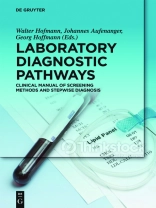The prognosis of a disease often depends on the timing of therapeutic invention, which in turn strongly relies on a reliable and quick diagnosis. Laboratory diagnostic pathways are algorithms that give structure to the diagnostic process, thereby minimizing the risk of mistreatment, shortening the hospital stay, and lowering the cost for treatment.
This book offers 70 diagnostic algorithms that lead physicians and laboratory personnel through the diagnostic process in a step-by-step fashion. In Part One, general basics, infrastructure, and economic aspects are discussed and tipps for implementation are given. Part Two introduces screening methods for cases without a suspected diagnosis as well as specific pathways for stepwise diagnosis of the most common diseases, accompanied by information on pathophysiology, preanalytical measures, implementation, and interpretation of results.
About the author
Walter Hofmann, München; Johannes Aufenanger, Ingolstadt; Georg Hoffmann, Grafrath.












